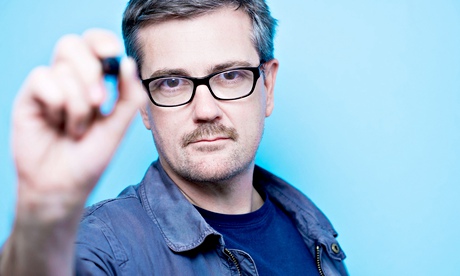
The humorist Stéphane Charbonnier, whose cartoons were signed Charb, died at the age of 47 in the attack last week on the offices in Paris of the French satirical weekly Charlie Hebdo. The publication’s editor and the main author of its editorials and cartoons against Islamic terrorists, he was the principal target of two gunmen who went on to kill 12 people.
Charbonnier made his professional debut as a contributor to La Grosse Bertha (Big Bertha, after the German first world war artillery gun), a satirical weekly opposing the Gulf war of 1991. After disagreements at the magazine the following year about the degree of political content, its editor, the singer Philippe Val, and Jean Cabut (the artist Cabu, who was also killed in the attack), left, taking with them other established contributors, as well as the next generation, including Charbonnier. They revived the title Charlie Hebdo, whose first incarnation had lasted from the death of Charles de Gaulle in 1970 until 1981. The revived publication first appeared in July 1992.
In the ensuing two decades, Charbonnier became a cartoonist essential to its character and an acerbic chronicler whose uncompromising humour knew no taboos. No one found favour in his eyes, but he was always careful to remain fair and accurate. He became deputy editor-in-chief and then succeeded as editor-in-chief when Val took over direction of the national radio station France Inter in 2009. He also acted as publishing director, managing the weekly as part of a trio with Laurent Sourisseau (the cartoonist Riss, injured in the attack) and Gérard Biard (in London at the time of the attack).
A staunch republican and militant atheist, Charbonnier was at the forefront at every stage of the clashes with fundamentalists, both Catholic and Muslim: in 2006 when Charlie Hebdo reprinted cartoons of the prophet Muhammad from the Danish newspaper Jyllands-Posten, and later when several covers pointed to what it portrayed as fundamentalist folly. As a result, fatwas were launched against Charlie Hebdo, and more specifically against Charb and Cabu. In 2013 the jihadist online magazine Inspire put Charbonnier in the same category as Salman Rushdie and Kurt Westergaard as “wanted dead or alive for crimes against Islam”.
Born in Conflans-Sainte-Honorine, in the Yvelines department, north-west of Paris, Stéphane grew up in another Parisian suburb, Pontoise. His father worked for the postal service, his mother was a secretary. His grandfather was on the extreme right, and as a teenager Stéphane argued with him.
Drawing from an early age, he participated in his college newspaper, then in local publications and a fanzine, before abandoning a training in advertising for La Grosse Bertha. As well as political cartoons, Charbonnier produced popular comic strips for Charlie Hebdo, which also appeared as books. Maurice et Patapon depicted an anti-capitalist dog and cat; Marcel Keuf, le Flic, showed a bigoted policeman; and Charbonnier lampooned the former French president Nicolas Sarkozy as an ailing vampire.
He also contributed to the series “I hate”, against tobacco and retirement, and illustrated books by his friends, such as La Vie de Mahomet by Zineb El Rhazaoui. His articles were compiled into collections – Charb N’aime Pas les Gens (his column in Charlie Hebdo about those he had taken against) and La Fatwa de l’Ayatollah Charb (his column in the humorous monthly Fluide Glacial). The other publications he worked for included the newspaper L’Humanité, and in 2007-08 he did drawings on a live TV show.
A hard worker and a good organiser, Charbonnier was, in addition to his atheism, secularism and republicanism, a pacifist, close to the Communists in outlook. However, he was also gentle, quiet and always ready to be ironic: he saw the world with a young man’s eternal melancholy. His very easy-going drawing style, in the French “big nose” tradition usually associated with light gags, contrasted with the sharpness of his words and made them extremely effective. That sharpness cost him his life, though his own choice of weapon would only ever have been a pencil.
In 2011, Charlie Hebdo’s offices were firebombed. A few days after it published caricatures of the prophet Muhammad in 2012, Charbonnier told Le Monde: “I’ve got no kids, no wife, no car, no credit cards. Perhaps what I’m going to say sounds a bit pompous, but I prefer to die standing up rather than living on my knees.” He took the precaution of keeping quiet about his private life, though a year ago he formed a relationship with Jeannette Bougrab, a lawyer and former minister for youth and community life under Sarkozy.
His surviving family include his parents and a brother.
• Stéphane Charbonnier, editor and cartoonist, born 21 August 1967; died 7 January 2015

